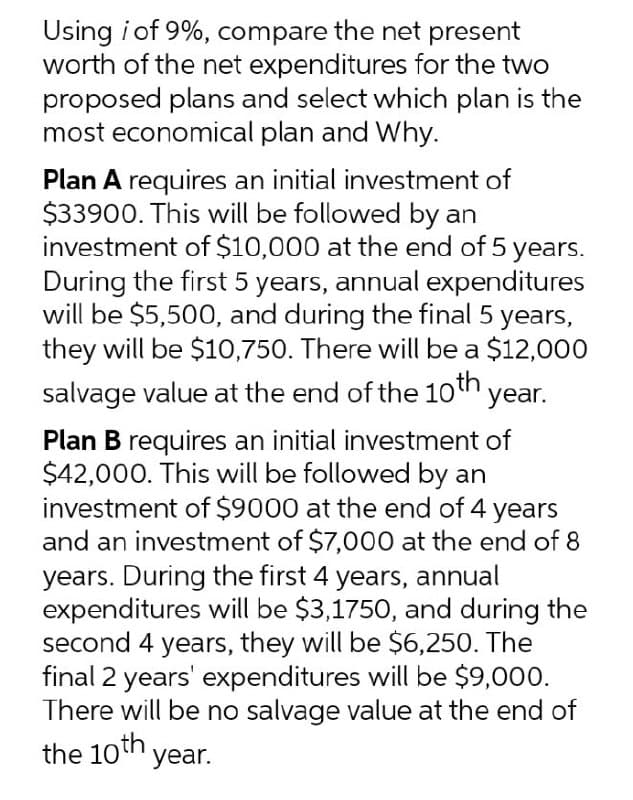Using i of 9%, compare the net present worth of the net expenditures for the two proposed plans and select which plan is the most economical plan and Why.
Using i of 9%, compare the net present worth of the net expenditures for the two proposed plans and select which plan is the most economical plan and Why.
Financial And Managerial Accounting
15th Edition
ISBN:9781337902663
Author:WARREN, Carl S.
Publisher:WARREN, Carl S.
Chapter26: Capital Investment Analysis
Section: Chapter Questions
Problem 3CMA
Related questions
Question

Transcribed Image Text:Using i of 9%, compare the net present
worth of the net expenditures for the two
proposed plans and select which plan is the
most economical plan and Why.
Plan A requires an initial investment of
$33900. This will be followed by an
investment of $10,000 at the end of 5 years.
During the first 5 years, annual expenditures
will be $5,500, and during the final 5 years,
they will be $10,750. There will be a $12,000
salvage value at the end of the 10th year.
Plan B requires an initial investment of
$42,000. This will be followed by an
investment of $9000 at the end of 4 years
and an investment of $7,000 at the end of 8
years. During the first 4 years, annual
expenditures will be $3,1750, and during the
second 4 years, they will be $6,250. The
final 2 years' expenditures will be $9,000.
There will be no salvage value at the end of
the 10th year.
Expert Solution
This question has been solved!
Explore an expertly crafted, step-by-step solution for a thorough understanding of key concepts.
Step by step
Solved in 4 steps with 2 images

Knowledge Booster
Learn more about
Need a deep-dive on the concept behind this application? Look no further. Learn more about this topic, finance and related others by exploring similar questions and additional content below.Recommended textbooks for you

Financial And Managerial Accounting
Accounting
ISBN:
9781337902663
Author:
WARREN, Carl S.
Publisher:
Cengage Learning,

Managerial Accounting
Accounting
ISBN:
9781337912020
Author:
Carl Warren, Ph.d. Cma William B. Tayler
Publisher:
South-Western College Pub

Cornerstones of Cost Management (Cornerstones Ser…
Accounting
ISBN:
9781305970663
Author:
Don R. Hansen, Maryanne M. Mowen
Publisher:
Cengage Learning

Financial And Managerial Accounting
Accounting
ISBN:
9781337902663
Author:
WARREN, Carl S.
Publisher:
Cengage Learning,

Managerial Accounting
Accounting
ISBN:
9781337912020
Author:
Carl Warren, Ph.d. Cma William B. Tayler
Publisher:
South-Western College Pub

Cornerstones of Cost Management (Cornerstones Ser…
Accounting
ISBN:
9781305970663
Author:
Don R. Hansen, Maryanne M. Mowen
Publisher:
Cengage Learning

EBK CONTEMPORARY FINANCIAL MANAGEMENT
Finance
ISBN:
9781337514835
Author:
MOYER
Publisher:
CENGAGE LEARNING - CONSIGNMENT

Principles of Accounting Volume 2
Accounting
ISBN:
9781947172609
Author:
OpenStax
Publisher:
OpenStax College
